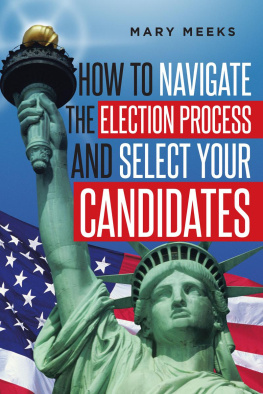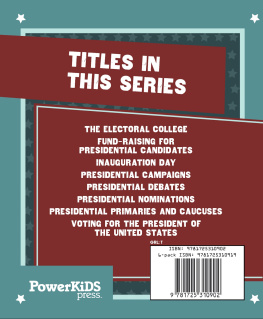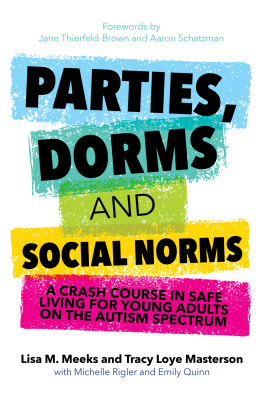'How to navigate the election process and select your candidates
Mary Meeks
Copyright 2018 Mary Meeks
All rights reserved
First Edition
Page Publishing, Inc
New York, NY
First originally published by Page Publishing, Inc 2018
ISBN 978-1-64214-382-9 (Paperback)
ISBN 978-1-64214-383-6 (Digital)
Printed in the United States of America
Acknowledgements
Thank you, Angie, for prompting me to write this book, and for your feedback along the way.
Thank you, Julia, for providing content suggestions and writing the summary.
Thank you, Charlotte, for your encouragement and telling me I should write books.
Thank you, Dad, for teaching me to consider perspectives beyond my own as I form opinions, and expecting me to be my best through lifes twists and turns.
Introduction
The more people who thoughtfully engage in our election process the more representative our government will be. To that end, the purpose of this book is to equip people with strategies to determine which political candidate to vote for without being swept up in the drama that, sadly, is prevalent in our election cycles. Begin to notice when your feelings are manipulated. Doing so will empower you to navigate election season well.
Our system of government is designed for and depends on citizens participation. Unlike many countries, we do not have royalty or a designated ruling class that is above the law. We have the unique opportunity to select from our peers who will represent us. If they do not keep their word, we have the power to remove them from office by replacing them with someone else in the next election. We need not be victims of corrupt leadership. A peaceful, orderly transfer of power is our heritage. By educating yourself and voting, you become part of the solution.
Chapter 1
Voter Registration
Find out when elections are held in your area, then mark your calendar. Some years there are two elections, some years there may be none. Typically, there are deadlines before which you must register to vote in order to participate in an election. Ask your states Board of Elections what they are in your area and plan accordingly. If you miss the deadline, register anyway so you can participate in the next election. It might be sooner than you think!
If you are already registered to vote, confirm the Board of Elections has your current information including your name and address.
Voter registration is handled by your state of residence, likely by their Board of Elections . To start, do a web search with voter registration, plus the name of your state. Some states assist in voter registration by offering the service through the Department of Motor Vehicles when you initially register your vehicle. You may be required to select a political party. While there are several, the most common are: Democratic, Libertarian, and Republican. You could conduct an internet search to learn your options. If you are new to the process or simply do not fit into any given political partys way of thinking, selecting Independent may be appropriate for you if that is an option in your state.
If you have difficulty finding the information online, ask a reference librarian at the local public library to assist. You could also ask a trusted friend to help.
Chapter 2
Sample Ballot
Your sample ballot is your GPS of sorts. It is a key component to getting you through election season while maintaining your sanity.
It is a preview of your ballot. To learn when it will be available and how you can access it, conduct an internet search with sample ballot vote (your state) . Once you have arrived at the site, you will be asked to enter information such as your name. This ensures you will view your ballot, and not your neighbors which may be different depending on how boundaries are drawn. Then download and print a copy to use as a research guide. It lists all offices, candidates, and local issues you will see on your actual ballot. If you are not registered to vote, you may not have access to a sample ballot.
Such ballots are only available for a designated length of time prior to any election. You may get this information directly from your states Board of Elections. When you see the first yard sign or hear the first political radio ad, you will know it is time to obtain your sample ballot and begin your research.
Your ballot may include candidates for federal, state, and local offices, in addition to state or local ballot initiatives. Some political offices allow candidates to mention which party they affiliate (partisan), other offices, such as judicial seats, do not (nonpartisan). Federal offices include president, US senator, and US representative. State offices include governor, state senator, state representative, clerk of superior court, district court judge, and district attorney. Local offices include mayor, county commissioner, sheriff, and board of education. Referendums and ballot measures may also appear on your ballot.
If this is overwhelming, pause. Simply choose one candidate or one issue to research and begin. (Instructions are found in the next chapter.) Continue researching when you are ready. On election day, bring your completed sample ballot with you to the voting booth. No need to memorize your selections!
On election day, your ballot may offer straight party voting as an option. That means if you select one party, the vote counting machine will automatically vote for all candidates in that party up for election. For example, if you select straight-party Republican, it will select all Republicans on the ballot and vote for them. If you select straight-party Democrat, it will select all Democrats on the ballot and vote for them. I urge you not to take this option as it has become common for politicians to masquerade as something they are not, only to show their true colors after elections. You are an individual with the capacity for thought, thus, let your thoughts be heard. By voting for each candidate you researched one at a time. Note that nonpartisan offices and local issues are not included when one selects the straight party option.
After election night, stay engaged. You may need to vote again in a runoff election. Once election results are settled and their term begins, contact your elected official periodically with your perspective on specific issues. How can they know what you want if they do not hear from you? Communicating with them will help them represent you.
Elected officials contact information will be found on their government website. Conduct an internet search including their last name, office, state, and gov. Their official government site will offer a variety of ways to contact them by physical mail, phone, etc.
Chapter 3
How to Research a Candidate
The process of researching a candidate has multiple layers and is a bit like peeling back the layers of an onion. First locate a source of information, gather data on issues and endorsements, examine them, then notate any gaps in information (what was left out or glossed over). Consider the tone in which information is conveyed, the behavior of each candidate, and the behavior of those who endorse them. This research process will require you to think, ask, and decide.
Use primary and secondary sources to uncover information. A primary source will be the candidate themselves, or what they say about themselves in advertisements or on their website. If it is feasible, meet the candidate and listen to what they say about their policies. Ask questions. Secondary sources will be websites, news articles, radio, and other advertising by those who endorse the candidate. Keep in mind, some people speak the truth and others deceive. This is one reason it is important to dig a bit for information and to inspect their endorsements to capture an accurate picture of who your candidates are.










